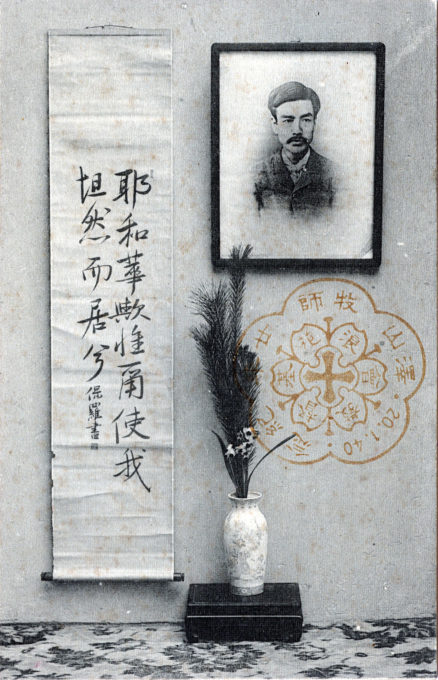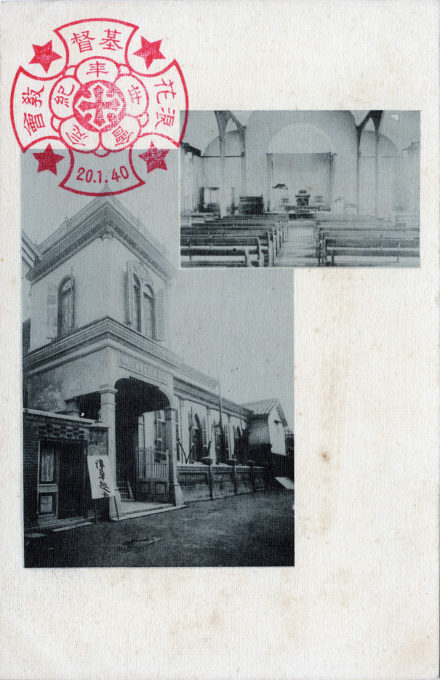
30th Anniversary of the Naniwa (Osaka) Christ Church commemorative postcard, 1907, picturing a reverent tokonoma display celebrating the life of Paul Sawayama (1851-1887), founding pastor of Naniwa Christ Church. Sawayama and his contemporary, Joseph Neesima, founder of Doshisha University, were considered two of the most influential Protestants among early post-Restoration Japanese Christian converts.
See also:
Hiogo Baptist Church, c. 1910.
Friends (Quaker) Ministers in Japan, c. 1920.
St. John’s Episcopal Church, Asakusa, Tokyo, c. 1920.
“The celebration of the thirtieth anniversary of the Naniwa Church of Osaka has directed the thoughts of the older Christians to its founder and first pastor, the Rev. Paul Sawayama, a unique man among the Christians of Japan. He has been called the ‘Pastor of Pastors’ by one who for several years was his contemporary in Osaka.
“Mr. Sawayama was born, it would appear, in the year 1852 in the province of Choshu which has produced so many men who have distinguished themselves in the recent history of Japan – Marquis Ito, Marquis Yamagata, General Baron Kodama, and others too numerous to mention.
“… From early youth he seems to have had a warm religious nature – indeed on one occasion he retired to the mountains in the hope that he might by prayer and fasting become a sennin, a legendary being, representing a purified humanity and partaking in some degree of the divine nature.
“… Mr. Sawayama in 1872 went to Evanston, Illinois, where he spent four years, the first in the family of Mr. Samuel Green, now Rev. Samuel Greene, D.D., and the remaining three with Mr. and Mrs. L.H. Boutell.
“He made excellent progress in his English studies and when he returned to Japan, it seemed to me that, while his speech was not without faults, he had caught the spirit of the language to a remarkable degree. He felt the force of the English idion more justly, I often remarked, than any other Japanese I knew.
“While there is every reason to believe that when he went to America, his purpose was to enter the [Japanese] Government service, he soon decided that duty called him to the missionary work, and this decision was clear cut and final … On his return to Japan, his friends urged him to take a position under the Government … He decided, however, to cast his lot with the Naniwa Church on the basis of self-support … While this Church absorbed his best strength he gave much time to the establishment of the Baikwa [Plum Blossom] Girls’ School, and was also one of the prime movers in starting the Taisei Gakkwan, a school for young men, which for many years was a most important institution. He was a man of intense public spirit and interested in every movement which gave promise of usefulness.
“But for all this, he was first and always a pastor, and that of a highly spiritual type. The Gospel was to him, as to his great namesake, the power God unto salvation.
“… He left the church also a rich legacy of faith, faith of the strong unwavering kind, a faith which worked by love, and which overcame the world. It is hardly an overstatement to say that thousands who never knew him have received that legacy at the hands of his spiritual children. Though dead he yet speaketh.”
– “Paul Sawayama”, by D.C. Greene, Mission News: A Journal of Religious and Social Progress, February 15, 1907


